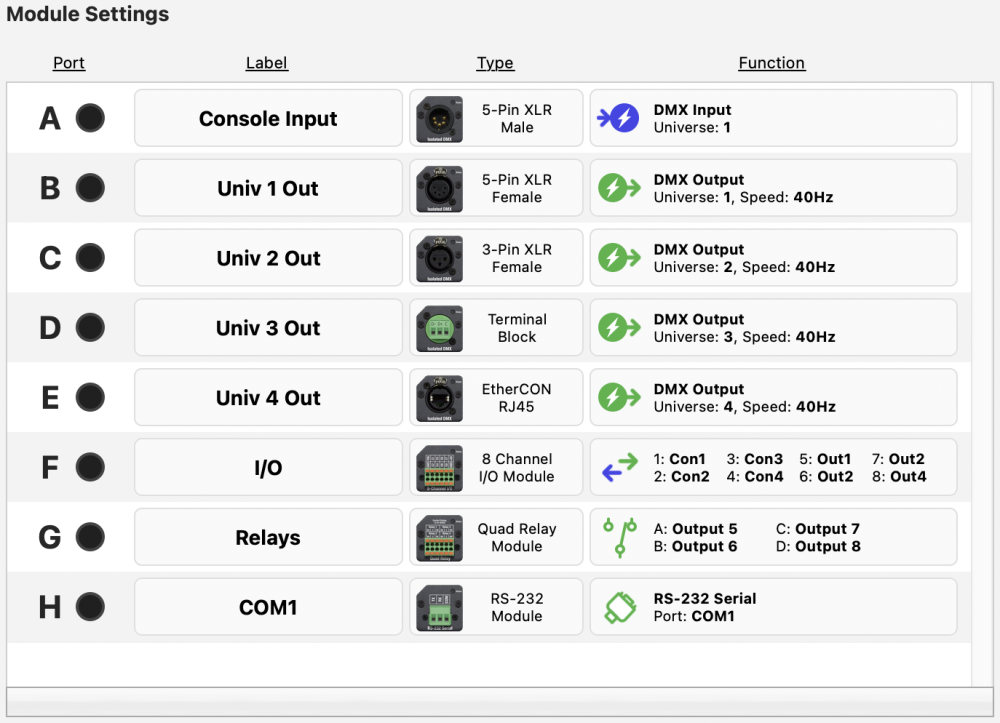Overview
The DMX Ports / Modules editor is where built-in ports and module slots are configured.
For information about using protocols such as sACN, Art-Net, and KiNET, see the Universe Patch section.
Port Label
Each port is labeled with a letter, such as “Port A”, but a custom label can be provided to help with identifying its function.
To add a label, click on the label block and enter a name in the resulting input field.

Use the enter key or click outside of the label block to confirm the label.
Port Type
Each port is configured with a port type. The configured type should match the physical hardware.
To change a port’s type, select the type block and choose the desired type from the resulting menu.
Not all models support all types, the menu will display the supported types for the current model at the top, with unsupported types in a separate list at the bottom.
Note that if a chosen type is incompatible with the current CueServer model, a caution icon ( 
Below are the available types:
| Type | Hardware |
|---|---|
 |
– |
 |
Fixed RJ45 Jack |
 |
Fixed Terminal Block |
 |
SM-DMX-RJ45 CS-MOD-RJ45 |
 |
SM-DMX-TB CS-MOD-TB-ST |
 |
SM-DMX-IDC CS-MOD-TB-IDC |
 |
SM-DMX-X5F CS-MOD-X5F |
 |
SM-DMX-X5M CS-MOD-X5M |
 |
SM-DMX-X3F CS-MOD-X3F |
 |
SM-DMX-X3M CS-MOD-X3M |
 |
SM-IO8 |
 |
SM-RELAY4 |
 |
SM-RS232 |
Port Function
The port function defines how the port operates. Depending on the selected port type, various configuration options are available.
Select a port’s function block to change its configuration.
DMX Ports and Modules
The following port types are included in this category: Fixed Terminal Block, Fixed RJ45, X5M, X5F, X3M, X3F, Terminal Block, IDC, RJ45.
The following options are available:
| Function | Additional Options |
|---|---|
| DMX Input | Universe – the internal CueServer universe incoming DMX data is mapped to. |
| DMX Output | Universe – the Internal CueServer universe to output. Rate – the DMX Update rate. |
| Station Bus | Hub ID – the hub ID used for the station network. |
| RS-485 Serial | Port – the assigned COM port (1-8) on station 0. |
I/O Module
Each of the eight I/O ports can be individually configured with the following options:
| Function | Additional Options |
|---|---|
| Off | – |
| Contact-Closure | Number – the assigned contact number on station 0. |
| Digital Output | Number – the assigned output number on station 0. |
Relay Module
Each of the four relays can be individually configured with the following options:
| Function | Additional Options |
|---|---|
| Off | – |
| Digital Output | Number – the assigned output number on station 0. |
RS-232 Module
This module has the following options:
| Function | Additional Options |
|---|---|
| Off | – |
| RS-232 Serial | Port – the assigned COM port (1-8) on station 0. |
Extended Functionality
When assigning an I/O, Serial or Relay module, the port configuration determines which resources those items point to. The additional configuration options or rules are defined in the resources themselves.
RS-232 & RS-485
Modules with serial functions use the COM (n) parameter to define which COM port the module is assigned to on the Built-In station. Options such as protocol, baud rate, and data format are configured in the corresponding port’s settings.
The number of available COM ports on the Built-In station is defined in the Station Settings panel under Resources. Once added, ports appear in the list on the left, below Buttons, Contacts, and Outputs.
I/O & Relay modules
Modules that are assigned Contact Closures or Digital Outputs are configured in the Built-In station. Functions and rules for each are configured in the corresponding contact or output settings.
The number of available Contacts or Outputs on the Built-In station is defined in the Station Settings panel under Resources. Once added, the contacts and outputs appear in the list on the left, below Buttons.
Station Bus
In this mode, DMX modules (or fixed RJ45) can be used to directly connect up to 24 individual 5-Wire CueStations (such as Mystique or Ultra stations) to a CueServer without the need for a separate station controller hub.
Once connected to the module (and external 24VDC power supply), stations can be added from the Stations panel using the station address and module Hub ID.


